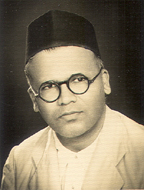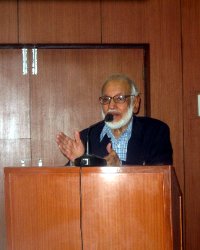
V.V. Narlikar |
V.V. Narlikar Memorial Lecture
V.V. Narlikar Memorial Lecture was instituted by the Centre, in the memory of V.V. Narlikar, who was considered a great teacher and mathematician. His name is particularly a source of inspirations for researchers in Universities.
- 6th V V Narlikar Memorial Lecture
Quest for Cosmic Origin
Prof Tarun Souradeep
10th February 2025, 4 PM. - 5th V V Narlikar Memorial Lecture
Black Holes, Quantum Stars and Gravitational Waves
The Emerging New Frontiers in Astrophysics and Cosmology
Prof Pankaj S Joshi
14th November 2018 - 4th V V Narlikar Memorial Lecture
The LIGO-India Project
Gravitational Wave Astronomy from India
Prof Ajit Kembhavi
18th March 2013 - 3rd V V Narlikar Memorial Lecture
Cosmic Rays: The legacy it has bequeathed us and its ramifications possible
Prof M G K Menon
17th March 2011 - 2nd V V Narlikar Memorial Lecture
Prof. Sirajul Hasan
Director, Indian Institute of Astrophysics, Bangalore
28th October 2009 - 1st V V Narlikar Memorial Lecture
Why do we live in four dimensions?
Prof. Naresh Dadhich
Inter-University Centre for Astronomy & Astrophysics, Pune
23rd January, 2009
V.V. Narlikar - Teacher-mathematician
Vishnu Vasudev Narlikar, was born at Kolhapur on 26 September 1908. He had his school education at Kolhapur and college education at Elphinstone College and the Royal Institute of Science, Bombay. After passing the B Sc honours examination of Bombay University in 1928 with 96 per cent marks in mathematics, he went to Cambridge for higher studies. There in 1930, he passed the mathematics tripos. His research career began with studying Liapounov's famous paper on rotating fluid bodies. For a written review of Liapounov's method and achievement, he was awarded the Isaac Newton students hip in October 1930.
Narlikar returned to India in 1932. In that year, when he was a young man of twenty four. The late Pandit Madan Mohan Malviya persuaded him to join Banaras Hindu University as head of the department of mathematics. Narlikar taught mathematics at BHU for 28 years till 1960. After a stint with the Rajasthan Public Service Commission (as its chairman) for six years, he became Lokmanya Tilak professor of mathematics at the University of Poona in 1966. After retirement in 1973 he lived with his elder son, the well-known cosmologist Prof. Jayant Narlikar.
For Narlikar teaching and research were complementary. He could best be described as a teacher-mathematician. A teacher-mathematician - more than a teacher and a mathematician - is one who uses teaching methods in mathematical research and research methods in mathematics teaching. At BHU, in addition to general relativity and Riemannian geometry, Narlikar taught several other topics: modern algebra; groups, characters and applications; wave mechanics; spinors and their applications; Hilbert's space and quantum mechanics; stellar structure; etc. His philosophy of teaching can best be judged from his writings and lectures.
At one place he has stated, 'When I started teaching mathematics at Banaras, I was more self-critical and I found that there were so many gaps and voids in my understanding of the topic I taught.' Elsewhere he has pointed out the reasons for these gaps: 'Mathematics of the eighties is going to be different from that of the seventies just as the mathematics of the seventies was different from that of the sixties. The mathematics that I learnt as a student differed very much from the mathematics I was called upon to teach.' He therefore concluded, 'The first lesson that I learnt was: one cannot be a good teacher, a successful teacher, without being always absorbed in the research topics concerned with his lectures.' His mathematics classes were always enjoyable and his popular talks on mathematical topics were always well appreciated because of his research oriented method of presenting a topic.
Narlikar was a pioneer relativist in India. After joining BHU he had several student collaborators working with him in relativity. Soon this evolved into an active research school at BHU and later at Poona. The main research areas cultivated by this school were:
- exact solutions of Einstein's equations of general relativity
- the solutions of the unified field equations of Einstein and of, Schrodinger equations of motion as derived from field equations
- the fourteen scalar differential invariants of the Riemannian metric and their physical significance
- the geometrical and physical properties of metrics satisfying Einstein's field equations.
About 20 young men were associated with him in research in these areas during 1932 to 1973. Most of them got doctorates, but what is more important, many of them continued their research and formed their own research groups. Thus a small seedling planted by Narlikar at BHU in the early thirties (and by Prof. N. R. Sen at Calcutta in the late twenties) has now flowered into a big banyan tree.
Narlikar was one of the founding fellows of the Indian Academy of Sciences. He was president of the Calcutta Mathematical Society (1958--60) and of the Indian Mathematical Society (1981). But above all, he was revered by the present generation of Indian relativists as Grandpa Narlikar. He died on 1 April 1991. [adapted from an article by Prof. P C Vaidya in Current Science 60 502 (1991)]

Prof. M.G.K. Menon delivering the 3rd V.V. Narlikar Memorial Lecture.
